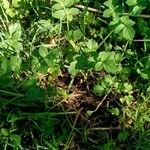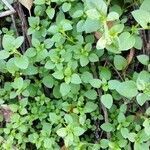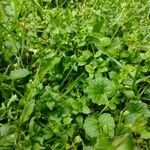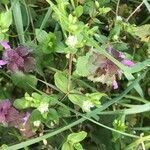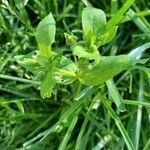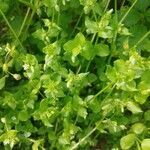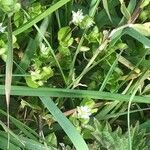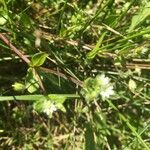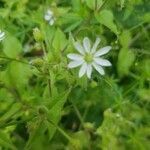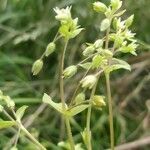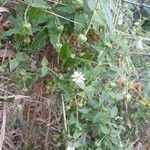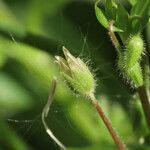Plants annual or winter annual, green, with slender taproot. Stems decumbent or ascending, diffusely branched, 4-sided, 5-40 cm, with single line of hairs along each internode. Leaves petiolate (proximal) or ± sessile (distal); blade usually green, ovate to broadly elliptic, 0.5-4 cm × 2-20 mm, base round to cuneate, margins entire, apex acute or shortly acuminate, ± glabrous or ciliate at base. Inflorescences terminal, 5-many-flowered cymes; bracts ovate and shortly acuminate to lanceolate-acute, 1-40 mm, herbaceous. Pedicels ascending, usually straight, deflexed at base in fruit, 3-40 mm, usually with line of hairs. Flowers 2-5 mm diam.; sepals 5, with obscure midrib, ovate-lanceolate, 4.5-5(-6) mm, margins narrow, scarious, apex obtuse, usually glandular-hairy; petals absent or 5, 1-4 mm, shorter than to equaling sepals; stamens 3-5(-8); anthers red-violet; styles 3, outwardly curved, becoming curled, 0.5-1 mm. Capsules green to straw colored, ovoid-oblong, 3-5 mm, somewhat longer than sepals, apex obtuse, opening by 6 valves; carpophore absent. Seeds reddish brown, broadly reniform to round, 0.9-1.3 mm diam., with obtuse, round, or flat-topped (broader than tall) tubercles. 2n = 40, 42, 44.
Annual herb with diffuse leafy stems; stems with a single line of hairs down each internode. Lower leaves on petioles of c. 1.5 cm; lamina c. 1 x 1 cm, ovate to very broadly ovate, apex mucronate, base broadly cuneate, upper leaves usually somewhat larger, ± sessile, ovate or broadly elliptic, apex acute or shortly acuminate, glabrous or ± ciliate near the base. Flowers in terminal, often leafy dichasia; pedicels c. 1 cm long, slender, usually with a line of hairs. Sepals 5, 3.5-5 mm long, ovate-lanceolate, acute or obtuse with a narrow membranous margin, usually glandular-hairy outside. Petals white, somewhat shorter than the sepals, bifid to near the base, sometimes absent. Stamens 3-10, c. 1/2 the length of the sepals, with red-violet anthers. Ovary globose; styles 3, 1 mm long, slender, spreading. Capsule ovoid, opening from the apex by 6 teeth or valves, exceeding the persistent sepals in length only very slightly, pedicels usually turning downwards in fruit. Seeds fairly numerous, reddish-brown, 0.9-1.3 mm in diam., somewhat discoid, minutely tuberculate.
Herbs annual, biennial, or perennial. Stems decumbent or ascending, pale purplish, 10--30 cm tall, sparsely branched at base, with 1(or 2) lines of hairs. Basal leaves long petiolate, distal leaves sessile or shortly petiolate; leaf blade broadly ovate to ovate-orbicular, 0.8--2.5 × (0.5--)1--1.5 cm, base narrowed or cordate, apex acuminate or acute. Flowers in sparse terminal or axillary cymes. Pedicel 0.7--1.4 cm, elongate and nodding after anthesis, slender, with 1 line of hairs. Sepals 5, ovate-lanceolate or ovate-oblong, ca. 2--2.5 or 4 mm, outside glandular pubescent, margin broadly membranous, apex slightly obtuse or nearly rounded. Petals oblong, shorter than or subequaling sepals, 2-cleft nearly to base; lobes nearly linear. Stamens 3--5, shorter than petals. Styles 3, linear. Capsule ovoid, slightly longer than persistent sepals, 6-valved. Seeds numerous, red-brown, ovoid to compressed globose, 1--1.2 mm in diam., semiglobose-tuberculate or curved reticulate. Fl. Jun--Jul, fr. Jul--Aug. 2n = 40, 42, 44.
Polymorphous annual or biennial herb. Stems weak, decumbent or ascending, terete, with a single row of hairs on alternating sides of successive internodes. Leaves glabrous, or ciliate near the base, broadly ovate to ovate-elliptic, acute or acuminate, with a petiole of varying length, longest at the base, up to 12 mm, upper leaves subsessile, 5-30 by 3-20 mm. Flowers solitary or in lax cymes; pedicels filiform, 5-25 mm, glabrous or with one line of simple hairs, rarely glandular pubescent, after anthesis declinate, later in fruit erect. Sepals ovate-oblong, obtuse or acutish, 3-6 mm, often glandular hairy outside, particularly towards the base, 3-nerved. Petals (4 or) 5, rarely absent, slightly shorter than the calyx, spathulate, glabrous, deeply divided. Stamens 3-5, rarely more, 1-2.5 mm. Ovary ovoid to ellipsoid, c. 1 mm; styles 3, 1-1.5 mm. Capsule longer than calyx, opening by 4-6 valves. Seeds compressed, reniform, c. 1 mm, reddish brown or brown, tuberculate.
Annual. Stems weak, ascending, terete, (10)-15-40-(60) cm long, with 1 line of hairs. Lvs green, not connate, ovate to broadly lanceolate, acute to apiculate, narrowing abruptly at base, ciliate on proximal margins and midrib above, 5-40-(50) × 5-15-(25) mm; petiole ciliate, c. = lamina in lower lvs, almost 0 in upper lvs; marginal vein distinct. Infl. terminal, cymose, usually lax, (1)-3-15-(50)-flowered. Bracts leaflike. Pedicels slender, patent, (5)-10-40 mm long, with 1 line of hairs. Sepals narrow-lanceolate, obtuse to subacute, not veined, (3)-4-6 mm long, hairy outside; margins scarious. Petals slightly < to slightly > sepals. Stamens (0)-3-5-(10). Capsule narrow-ovoid, = or slightly > calyx. Seeds dull brown, 0.9-1.2 mm long; tubercles triangular, sharp.
Annual, the weak, branched stems to 4 dm, puberulent in 1 or 2 broad lines; lvs mostly 1–3 cm, ovate to obovate, the upper sessile, the lower with progressively longer petiole, often ciliate toward the base or on the petiole, otherwise mostly glabrous; fls solitary or in small, terminal, leafy cymes; sep lance-oblong, 3.5–6 mm, obtuse or acutish, ± hairy and pustulate; pet shorter than the sep; stamens 3–5(10); fr ovoid, usually deflexed; seeds 0.9–1.2 mm, suborbicular, bluntly papillate, so that the margin looks wavy; 2n mostly=40–44. A highly variable weed of waste places, cult. areas, meadows, and woodlands, intr. from the Old World, but sometimes appearing like a native. Early spring–late fall. (Alsine m.)
An annual herb. It lies along the ground. It has lax slender stems. There is a single line of white hairs which run up the stems until they reach a joint. The stems are round in cross section. The leaves occur opposite. The lower leaves have stalks. The upper leaves do not have stalks. Leaves are oval and taper to a short point. The leaves are 1-3 cm long and 5-10 mm wide. Leaves are pale underneath. The flowers are purple in a flat topped arrangement with central flowers opening first. The fruit is an oval capsule. The seeds are red-brown.
Diffuse, slender annual, up to 300 mm tall, stems angular, sparsely and softly hairy all round. Leaves opposite, ovate. Flowers in terminal cymes, white, sepals 4.5-5 mm long, hairy, petals bilobed almost to base, slightly shorter than sepals, stamens mostly 3-10. Fruit an ellipsoidal capsule, splitting into 5 valves.
Diffuse annual, up to 0.30 m high, with a line of hairs down each internode. Leaves opposite, ovate. Flowers in terminal cymes, white; sepals 4.5-5.0 mm long; petals bilobed; stamens mostly 5-10. Flowering time June-Nov.
Annual herb, up to 0.15 m high. Stems slender, glabrous except for line of hairs from within leaf base to between next pair above. Leaves opposite; blade ovate. Flowers: styles 3; sepals 5; petals white; May-Nov.
Diffuse annual to 30 cm with a line of hairs down each internode. Leaves opposite, ovate. Flowers in terminal cymes, white, sepals 4.5-5.0 mm long, petals bilobed, stamens mostly 5-10.
Diffuse, slender, annual herb, up to 150 mm tall. Stems glabrous except for line of hairs from within leaf base to between next pair above. Flowers white.
